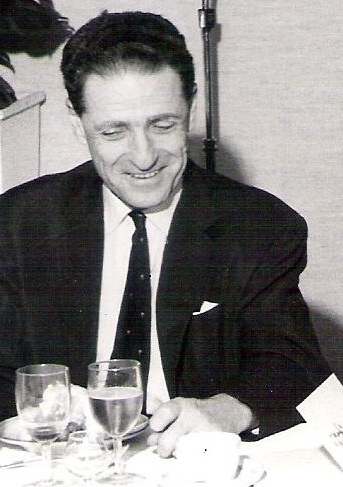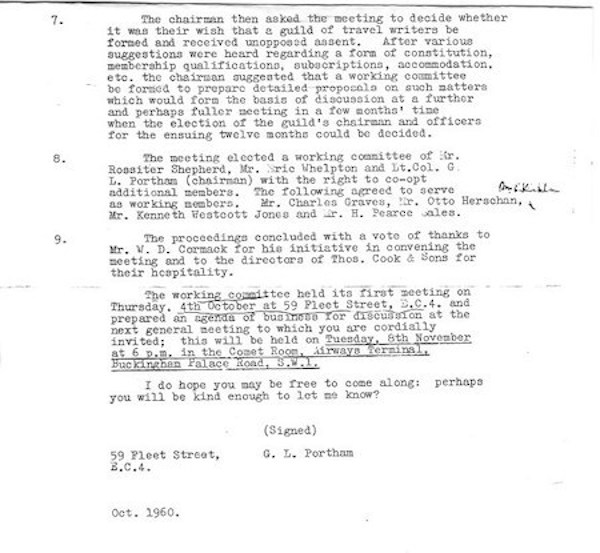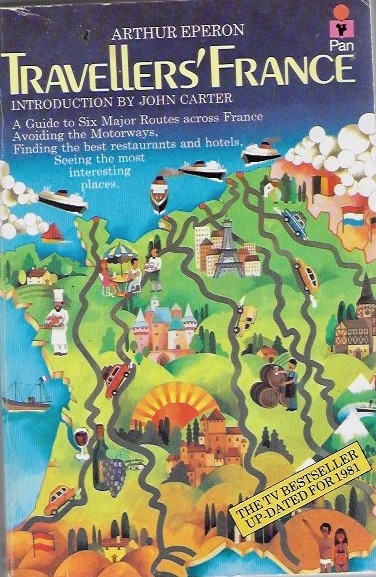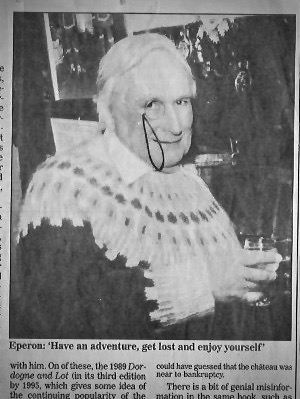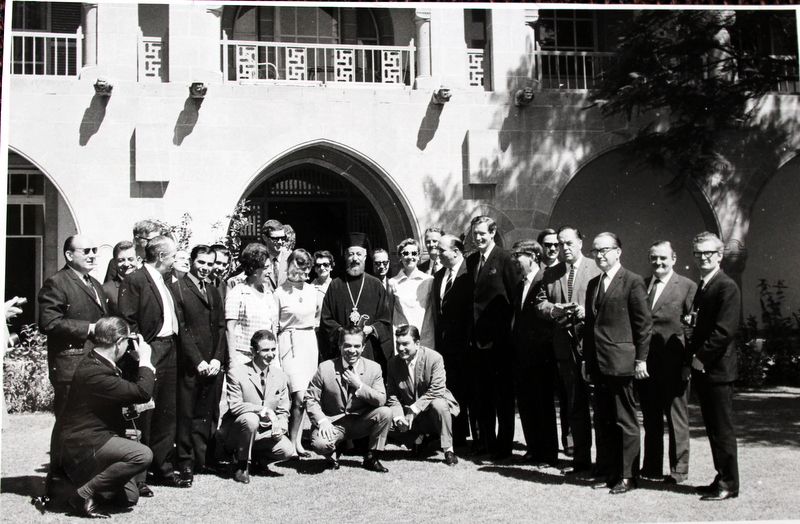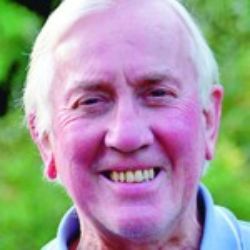The year 2020 was meant to herald a year of celebration. A time to fly the flag for reaching our 60th anniversary and an even brighter future. Now, crushed by the cruelty of Covid-19, the Guild looks fearfully into the unknown, facing tourism in all its shapes and sizes.
Which is not all that dissimilar to the situation faced by the determined group of travel writers who, back in the Sixties, formed the Guild as the industry struggled not with a virus but finding its feet at time when sun, sea and sangria was unfamiliar for the average family still recovering from the bleakness of post-war Britain.
So, let’s raise a glass or two and share the memories of those whose persistence proved, and is still proving, that changing times, including technology and social media, has not dampened a love of worldwide travel, coupled with hopefully a fresh emphasis on the environment and conservation.
Who exactly sparked the idea of the BGTW remains a bit of a mystery . Suffice to say mutterings among a score of hardcore professional travel writers came to a head when Bill Cormack, the gruff but highly respected PR for the late lamented Thomas Cook and later a member himself, suggested forming a Guild of their own stressing: ‘ It would help you and the industry too.’
He had good reason to do so. In collaboration with Elizabeth Nicholas, Travel Editor of the Sunday Times, he had already persuaded the national press to institute travel supplements in the first few weeks of the year.
On November 6, 1960, their dreams were fulfilled with a code of conduct and objectives drawn up by 15 writers who met in the BOAC (British Overseas Airways Corporation) Comet Room at Victoria Station.
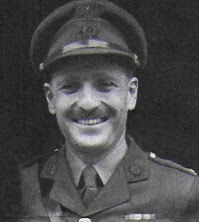
It is no coincidence that the first chairman was Lieut-col Geoffrey Portham. Like many founding members, his knowledge of travel was gained through his wartime service. Known as the Colonel, he remains a slightly mysterious figure who had had what was called ‘a decent war’, with much of it spent in Military Intelligence.
This is reinforced by his pre- 1939 Army records. These show Geoffrey as speaking fluent French, German and Spanish as well as learning Serbo-Croatian. Resident in Paris for two years, he spent eight months in Vienna, a further two months in Lithuania and Morocco respectively.
They also listed two years’ apprenticeship as a chartered accountant and a director of GP Tours and Travel Service Ltd specialising in Central Europe and Yugoslavia.
Geoffrey was also assistant correspondent for the New York Times during the 1935 Saar Plebiscite when 90 per cent of the region voted in favour of reuniting with Germany having been run by the League of Nations following the Treaty of Versailles. He also worked as a freelance journalist in Lithuania in 1935, as well as in Yugoslavia and Hungary.
All of which is likely to have linked him with Somerset Maugham who had worked for Military Intelligence in the 1914-18 war and was later to become the Guild’s honorary president.
Long after the war, Military Intelligence recruited Geoffrey to set up a ‘sting’ operation and recover essays, written by Prince Charles while at Gordonstoun, which had found their way to someone offering them for publication, but only at a price. An account of this appears in a copy of Globetrotter, pieced together by John Carter who joined the Guild in 1961 after his appointment as Travel Editor of the Kemsley (soon to be Thomson) group of regional newspapers.
Geoffrey was not alone: in 1985, my predecessor Russell Chamberlain, revealed that he had been instructed as a Royal Navy man to take the surrender of a German U-boat in the Channel on VE Day. He slipped while boarding and was only saved from falling into the sea by a German sailor.
It also turned out Arthur Eperon of Bomber Command had likewise been liberated after more than four years in German POW camps.
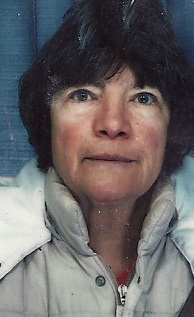
Flown after release from Stalag Luft 3 to Wolverhampton, he recalled ‘how beautiful the Kent coast looked from the mid-turret of a Lancaster bomber!’
Post-war sorties throughout Europe saw him visit German where asked by a somewhat bumptious guide in Hamburg if had visited the city before replied: ‘ Only to bomb it, dear boy.’
“Have an adventure”
France was always his true love with his book Traveller’s France, on which a TV series was based, selling many thousands of copies. His advice to would-be holidaymakers was ‘Potter. Avoid cities and motorways, have an adventure, get lost and enjoy yourself.’
Beginning as a trainee reporter on the Streatham News, Arthur progressed to the Daily Herald working alongside Michael Foot and John Betjeman. Promoted to the Foreign Desk he was ‘proud to have been thrown out of the Soviet Union and banned by General Franco in the same week.’
His experience proved instrumental in introducing a regular travel page which he edited, exploiting, too, his extensive knowledge of wine. Many older members will recall the plumpish figure, adjusting his monocle as, glass in hand, he extolled the joys of France which he shared with his wife Barbara.

Many others enjoyed the company of Chris Portway, described by former 1980-81 chairman Robin Mead as ‘a prolific writer but a man handicapped in face-to-face conversation by looking permanently scruffy and speaking with a nervous stutter.’
Writing is his book Press Trip, Robin tells the story familiar to many of how Chris, taken prisoner while a soldier in World War Two, escaped and was hidden by a Czech family.
While in hiding he fell in love with one of the family’s daughters, describing in several books his post war attempts to rescue his one true love from behind the Iron Curtain. He also wrote fiction books set in Communist East Europe.
Chris, who ended his days as a Chelsea Pensioner, also travelled light with his belongings sometimes contained in a plastic shopping bag.
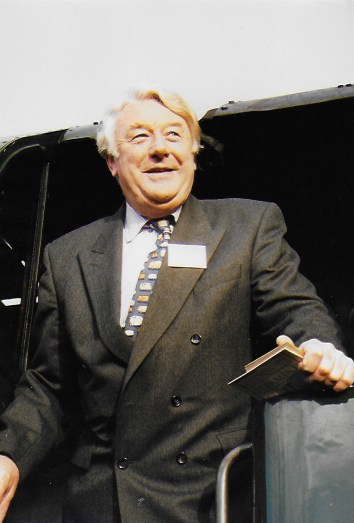
But arguably the most larger than life character must be Ken Westcott-Jones stories of which were still being told long after his death, mainly involving his passion for railways – and puddings.
The two somewhat bizarrely came together in December, 1997, when, according to Ken’s wishes, a small group of members, myself included, consigned his ashes to the firebox of a steam locomotive – in this instance a Merchant Navy class loco 35028 Clan Line.
This was one of the engines Ken had particularly mentioned as having hauled the Orient Express from Victoria. Former Guild member Angela Humphery happened to hand John Carter, then Guild chairman, a menu card praising some establishment’s fine pudding. So that went in as well…
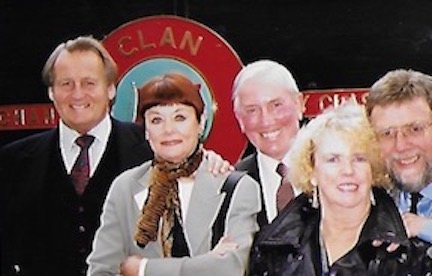
As for VE Day, Ken, a former naval officer, celebrated with a French group on a barge in the River Seine above Rouen.
An eccentric of the old school kind, he lived a bachelor’s existence in South Norwood amidst a unique clutter of travel memorabilia. Unwilling to cook for himself he often seemed to live on PR freebies, quite openly popping perhaps a few surfeit buns or cakes, or even a hard boiled egg, from a reception or restaurant, into his pocket.
Railways were his life. A prolific writer on the subject, witness the number of his books still on sale online, he appeared to know train timetables worldwide. So much so that on one press trip through Wales by steam train he became agitated when, in the middle of the night, he demanded that a slightly open carriage window must be shut tight immediately. Just as well. He had rightly deduced that they were approaching a remote spot where the loco took on water.
But then he was always a stickler for detail, not just when it came to train travel, but transport generally. Official guides, or speakers, too, were smartly told: ‘ Not so, sir ?” if he felt they were giving inaccurate information.
Prominent characters
Memorable, too, partly for his gold front teeth, was Jim Holloway ( dubbed Gold Fang by Michael Leech, another much loved character with a delightfully wicked sense of humour). Outwardly rather strait-laced, he would, plied with a few drinks and a piano, happily prove his prowess as a jazz player.
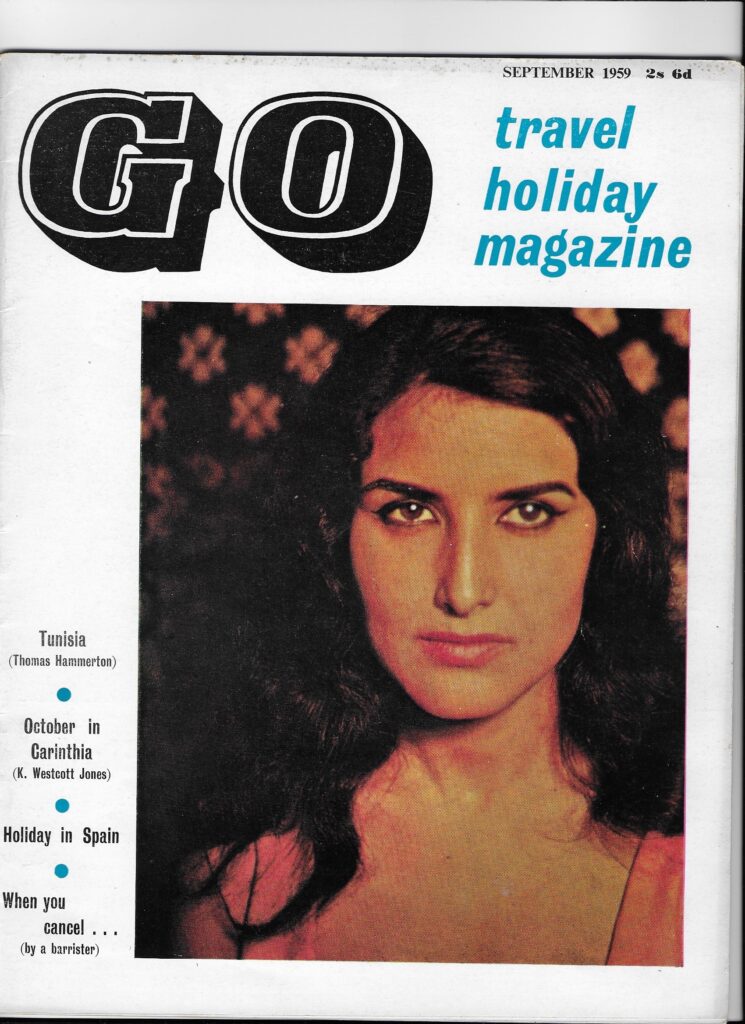
Others with wartime memories included Mary Elsy who was an ATS cypher operator at the War Office; Tony Kersting, a renowned photographer, was carrying out hush-hush work in the hills of Syria/Lebanon while Jim Holloway watched a parade from his RAOC office in New Delhi –still waiting for the war with Japan to end.
Not all original members, however, were wartime travellers. A young John Carter was encouraged to join the Guild by his predecessor at Thomson Regional, Philip Clarke, who had left the group to become editor of Go! a travel magazine, established by Geoffrey Portham in the early 1950s with the title sold to Jocelyn Stevens in the early ‘sixties.
‘Philip was a prominent member of the Guild from its inception, becoming chairman in its early years,’ said John. ‘ At the time, membership was around the 30 mark, small, but influential in those early days.’
John, who went on to become chairman twice – the first time between 1966-68 – recalled that, with the exception of Elizabeth Nicholas and Lewis de Fries (Sunday Express), most national newspaper travel editors were members.
“A somewhat majestic character”
Of these Peter Whelpton (Daily Mail), David Ash (Daily Express) and Paul Hughes (Daily Mirror) became Guild chairmen. So, too, did S. Rossiter Shepherd (The People), known affectionately as Ross, and described by John as ‘a somewhat majestic character with a pointed beard and of rotund appearance who toured the country holding wine tastings.’ He later joined, amid great fanfare, the now long defunct News of the World.

His replacement was Robin Dewhurst another longtime member. The circulation of the NoW at the time was around eight million and that of The People over five million. None can match such figures today.
‘ My main memory of those years’ said John, ‘apart from the gradually increasing membership and our boldness in going abroad for our AGM, concerns our annual dinner in 1965. This was to be held at the Charing Cross Hotel on December 17.
‘Ross was chairman at the time. On that morning I received news that Somerset Maugham had died at his home in the south of France. As he was the Guild’s president, I telephoned Ross to tell him that we should consider postponing our dinner.
‘I did not seriously mean this, but as Ross was a great trencherman, I knew the possibility of missing a good meal would cause him great distress, and could not resist teasing him. We quickly decided that the dinner should go ahead, with an appropriate moment of silence to honour our late President.’

Other staunch Guild supporters included Adrienne Keith Cohen (Guardian), Edna McKenna (Daily Sketch) and Cyril Ray (Observer). The most prominent of the members representing women’s magazines was undoubtedly Betty Jones of Woman’s Weekly.
John, who was Guild secretary around 1963 or 1964 recalled providing much sought after membership lists to mainly in-house PROs at tour companies, airlines, shipping companies, etc.
Travel organisations employing outside PROs, he said, tended to use only one of two agencies as, on the whole, they tended to shun travel accounts with tour operators being reluctant to pay the going rate for representation.
‘ Whenever possible, I would hand-deliver these membership lists in order to “mark the cards” of inquiring PROs. Even in our earliest days there were a few (very few, fortunately) members who freeloaded heavily and rarely delivered on their side of the arrangement.

‘As our ranks swelled, this minority increased, but was still hardly at all, which was a tribute to the vetting process. The letters “N.A.A.P.” against a name in the application list was a warning – “Not at any price”. It was probably against all the rules, but necessary in those first, faltering, days! ’
Becoming THE body for writers and photographers
Frustrated by the lack of interest shown by newspapers and magazines other than lucrative New Year supplements or advertorials, the Guild’s major aim was to establish itself as THE body for professional travel writers and photographers – and later for radio and television, which rarely, if ever, was mentioned at the time.
Well established Fleet Street or regional newspaper travel writers or editors helped them in their mission; others had already made their name as guidebook authors or by covering specialist subjects. Travel trade journalists, too, became members.
It also saw the founding of Sebastian Cash by Roger Smithells a syndication agency at a time when many magazines, for instance, had no specific travel contributors.
All of which came during a boom time for travel with Majorca’s new airport at Palma, opened in 1960, setting the pace for the likes of Thomson, Horizon and a host of other companies to dominate the burgeoning package deals of the late Swinging Sixties and into the early Seventies.
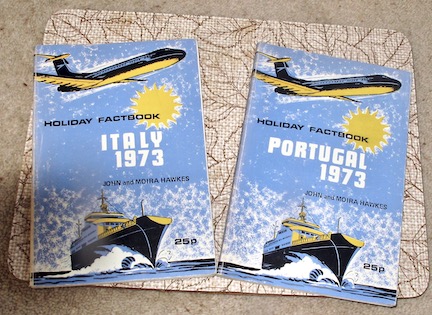
All were desperate to get media coverage – leaving the Guild to provide the genuine article when the media, to a large extent, were sniffy about what was too often labelled as ‘soft’ copy a trait that continues to a large extent even today.
Characterising trade co-operation in the early years were press trips highlighting new destinations arranged through Humphrey Downes of BEA (British European Airways); these were master-minded by the loveable wartime veteran Bill Simpson one of plastic surgeon Archie Mcindoe’s ‘guinea pigs’.
Well respected by Fleet Street air correspondents as well as travel writers he, and Ken Cook, did much to generate goodwill between the Guild and a major airline than anyone else.
Working with Ken was ex-Guild member John Henty who joined BEA as a feature writer bringing him into immediate contact with the founding members. He recalls meeting with Ken Westcott-Jones at their Lower Regent Street Office and discovering that they both went to the same school, Whitgift in Croydon (where incidentally John and I were fellow pupils, rotten at woodwork but not bad at English).
Arthur Eperon likewise was an Old Whitgiftian, ‘I will never forget the time when he and I sat at the rear of a BEA Vanguard aircraft as it struggled to take off from Gibraltar against strong cross winds.’ said John, ‘Red wine, Arthur’s favourite tipple, steadied our nerves on that occasion.’ John who was responsible for travel arrangements to the Malta AGM, left BEA in 1967 to become one of the first presenters on BBC Radio Brighton.
In 1968 he produced and presented the first travel programme on local radio. This eventually led to him joining the Guild, serving as a committee member under the 1987-89 chairmanship of Peter Hughes.
Cyprus, Denmark, Malta
Later to become chairman – twice, once serving from 1983-85 and again from 1989-91 – Carol Wright, joined the Guild in 1961 after being introduced by Geoffrey Portham a personal friend of her husband. Their first wedding anniversary was in November 1963 attending the AGM in Malta, staying in the Phoenicia Hotel in Valletta.
She vividly recalls a 1967 press trip to Cyprus leaving on a BEA flight on 11 October having been transferred from the next due flight for some reason. ‘I kept the 284 flight booking as a ghastly souvenir for a long time.’ she said. ‘The next flight Cyprus Airways 284 (in which BEA had a shareholding and joint operations) blew up in mid air and everyone on board was killed.
It took decades to find out the exact cause. Our group was welcomed by Archbishop Makarios, then head of state when we learnt the awful news. The BEA press officer supposed to be looking after us was sent to help the Greek press in the morgue to identify bodies etc and we were left to our own devices.’
Undaunted Carol recalls how along with member Sylvie Nickels, the press officer of Thomas Cook, and one other male travel writer they toured North Cyprus staying overnight in a monastery guest house recommended by Makarios as it was the one he had once been a monk.
‘It was a huge place with massive dormitories for guests,’ said Carol. ‘We were the only ones. The place was freezing, had no glass in the windows and being October was naturally cold in the mountains. Bunks and washing facilities were very primitive, but we had a jolly evening in the local taverna with the monk in charge of hospitality for the monastery.
‘The next day we rejoined the rest of the group, all very subdued. Our BEA press officer returned that evening exhausted and somewhat traumatised. To unwind him we gave him a party in the hotel.’
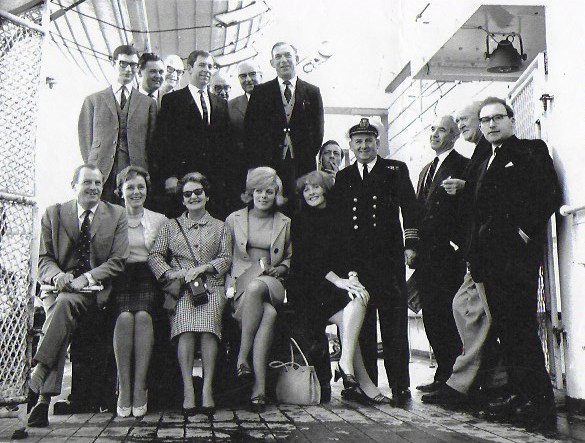
Carol also recalls another trip which, while not recalling the date, must have been ‘pretty early on in the Guild’s history as the Danes thought we were underfed. We were weighed in as a group on arrival and after around four days touring and eating the dairy rich Danish food were reweighed again on departure. The resultant increase in our tonnage (it did run to something like a ton) was headlined all over the Danish press.
‘We lost that weight very quickly on the very rough ferry trip home when I recall sitting at dinner and catching plates as they lurched off the tilting tables and putting them on the floor where they sloshed about round our feet…’
For me, another relic of the Sixties, it was more an era of escaping the relative calm of the Bromley & Kentish Times, where I was Chief Reporter, to that of Assistant Editor of Travel Agency magazine – and the crazy world of cocktail parties and press trips.
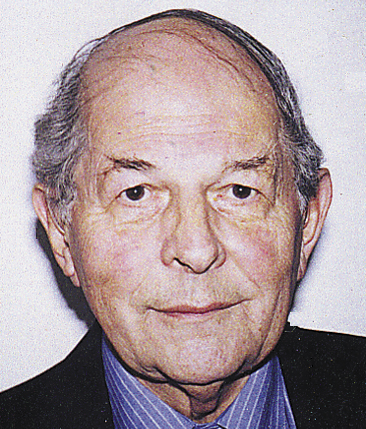
It also taught me the art of magazine layouts, deadlines and dealing with even more late nights than in my previous life.
But, boy, it was fun when, at 29, with one sole travel feature under my belt – a piece on the gradual greening of Germany’s Ruhrgebiet region for Lufthansa’s In- Flight magazine – I found myself one week with Roger Moore of 007 fame at the grand opening of the Tunis Hilton, the next on an educational cruise to Rotterdam with PATA (Pacific Area Travel Association).
It was on the latter that I was invited by John Carter to join the then relatively new Guild of Travel Writers. And so I did, not immediately but later, in 1966, when I left to join the Croydon Advertiser as a sub-editor and later as district editor and hence boss to John Sansom now a long time PR supporter of the Guild.
Even better I was also travel editor and with a pocketful of trade contacts joined the Guild at a time when its influence was already being felt.
Other events from the Sixties
- In October 1961 Jersey hosted the Guild’s first annual general meeting, which proved a glittering success with most of the hotels involved still with us today.
With a hint of things to come the 1961 committee discussed closer co-operation with the American Society of Travel Writers following a letter from the society’s president. In 2018 Guild chairman Alastair McKenzie signed a co-operation agreement with SATW and the Australian Society of Travel Writers… - J. Allen Cash, owner of a major photo agency, returned from China in 1964 after six weeks restriction-free photographing and travelling. He was the first Guild member to visit the country since the Guild’s formation.
- Among speakers booked for the monthly meetings in 1965 was Duncan Haws, managing director of Lunn-Poly who ‘ will have a few outspoken things to say about the travel industry.’
- In February of the same year, the Zeeland Shipping Company – which operated daily services between Harwich and the Hook of Holland – offered Guild members free first-class travel, a 50 per cent reduction for wives or husbands travelling with members ‘ in certain circumstances’ and free conveyance of members’ car, provided handing charges were paid.
- In August 1967 it was reported that the chairman had been invited to the Tokyo congress of the International Union of Official Travel Organisations. The purpose was to present a paper on tourism and the Press ‘ an excellent platform for airing Guild views.’
- But growth came at a financial cost. By 1967 the Guild’s finances were in ‘a really critical state’ with a mere £81 in the bank.
- A capitation fee of 10s a head (50p) to help pay for meetings was rejected as ‘such a charge would frighten members away.’ One answer was to raise the annual subscription then three guineas (£3.15p). It was agreed instead it should go up to a fiver !
Contribute to our history
Please feel free to send me your memories and, even better, dig out those old Guild photos stuffed in a drawer. It doesn’t matter from which decade. They can always be added to what will be an open-ended, and permanent, record of our history. Remember, what is happening now will be old hat by 2040! E-mail: [email protected].

